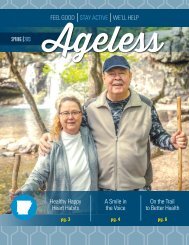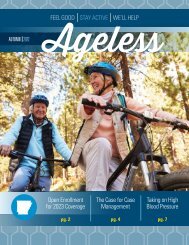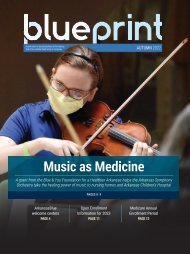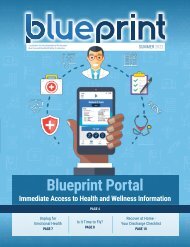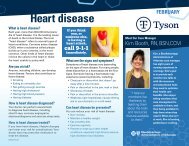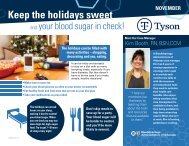Blueprint Autumn 2021
You also want an ePaper? Increase the reach of your titles
YUMPU automatically turns print PDFs into web optimized ePapers that Google loves.
“STROKE!” yelled the desk clerk toward the back of<br />
the ER, and large group of medical professionals<br />
immediately came running. From there Pat was wheeled<br />
into the CT scan, asked a million questions, had lights<br />
shown in her eyes, blood drawn, IV needles inserted and<br />
finally was placed on a stretcher and told not to move.<br />
In the midst of the chaos, a nurse practitioner came in<br />
close and looked directly into Pat’s eyes.<br />
“We are pretty sure you are having a stroke right now,”<br />
she said. “We’ve talked with your husband, and we want<br />
to give you tPA.” Pat couldn’t believe her ears. Tissue<br />
plasminogen activator (tPA) is a blood thinner that helps<br />
restore blood flow to the brain and can help reverse a<br />
stroke if given to carefully selected patients within a few<br />
hours of the onset of symptoms.<br />
“They don’t just give it to anyone,” Pat said, looking back.<br />
“It’s the best thing they’ve found to help during a stroke,<br />
but it can have side effects.” Since she was still thinking<br />
and talking clearly, Pat said it didn’t seem possible that<br />
she needed tPA.<br />
Since Pat’s son is a neuroscience nurse, he was allowed<br />
to come in and talk with her during her stay. “I was<br />
really lucky. He was able to tell me in detail what was<br />
happening. Even with the tPA, Pat required extensive<br />
physical and occupational therapy and still has<br />
swallowing and mild short-term memory issues.<br />
Still, she thinks about what might have happened<br />
if she hadn’t made that call to Virtual Health.<br />
What is Virtual Health?<br />
With just a click on your smartphone or computer, you<br />
can connect with experienced board-certified physicians<br />
and pediatricians around the clock. Virtual Health<br />
(powered by MDLIVE) gives you peace-of-mind if<br />
you’re a senior, parent, or just busy and on-the-go.<br />
“I was really lucky,” Pat said of her experience. She is<br />
back to work and back to walking with Mark. When friends<br />
ask how she is doing, she shares pictures of her crooked<br />
smile along with her experience with Virtual Health.<br />
The nurse practitioner quickly erased any doubt. “I want<br />
you to lift your right leg.” Pat looked down and willed<br />
her leg to move. Her toes to wiggle. Any movement<br />
at all. Nothing. Then the fear started to creep over her.<br />
The nurse reassured her, “tPA will fix this.”<br />
For the next three days, Pat barely slept as medical<br />
personnel prodded her with questions. “What’s your<br />
name? Where are you? Can you lift your arm? Can you<br />
touch your nose?” In the beginning it was every 20<br />
minutes, but slowly they spread out the checks to every<br />
hour, then every four hours. Pat could lift her right arm,<br />
but she couldn’t get it to stay up, or touch her nose.<br />
Using Virtual Health<br />
1.<br />
Activate your Virtual<br />
Health account<br />
Go to MyVirtualHealth.com<br />
and follow the simple steps to<br />
sign in or register to activate<br />
your account today!<br />
2.<br />
Choose<br />
a doctor<br />
Choose from a large<br />
network of state-licensed,<br />
board-certified doctors<br />
(including pediatricians)<br />
3.<br />
Start your visit<br />
Arkansas law requires your first call to be a<br />
video call. Have your health information handy<br />
(conditions you have and medicine you take). And<br />
be prepared to pay a copayment, coinsurance or<br />
deductible amount, if your health plan requires it.<br />
AUTUMN <strong>2021</strong> 9







